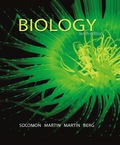
Concept explainers
To draw: A simple straight line to represent the chloroplast membrane that contains the photosynthetic pigments.
Introduction: Photosynthesis is a process by which carbon dioxide and water are broken down to produce glucose molecules by using energy from sunlight. During this process, oxygen gas is evolved. The reactions of the photosynthesis take place in the chloroplast of the plant cell which contains the green pigment chlorophyll.
To determine: The color of the chloroplast membrane that contains the photosynthetic pigments.
Introduction: Photosynthesis is a process by which carbon dioxide and water are broken down to produce glucose molecules by using energy from sunlight. During this process, oxygen gas is evolved. The reactions of the photosynthesis take place in the chloroplast of the plant cell which contains the green pigment chlorophyll.
To label: The two compartments in the chloroplast that are separated by the chloroplast membrane.
Introduction: Photosynthesis is a process by which carbon dioxide and water are broken down to produce glucose molecules by using energy from sunlight. During this process, oxygen gas is evolved. The reactions of the photosynthesis take place in the chloroplast of the plant cell which contains the green pigment chlorophyll.
Want to see the full answer?
Check out a sample textbook solution
Chapter 9 Solutions
EBK BIOLOGY
- Selection of Traits What adaptations do scavengers have for locating and feeding on prey? What adaptations do predators have for capturing and consuming prey?arrow_forwardCompetition Between Species What natural processes limit populations from growing too large? What are some resources organisms can compete over in their natural habitat?arrow_forwardSpecies Interactions Explain how predators, prey and scavengers interact. Explain whether predators and scavengers are necessary or beneficial for an ecosystem.arrow_forward
- magine that you are conducting research on fruit type and seed dispersal. You submitted a paper to a peer-reviewed journal that addresses the factors that impact fruit type and seed dispersal mechanisms in plants of Central America. The editor of the journal communicates that your paper may be published if you make ‘minor revisions’ to the document. Describe two characteristics that you would expect in seeds that are dispersed by the wind. Contrast this with what you would expect for seeds that are gathered, buried or eaten by animals, and explain why they are different. (Editor’s note: Providing this information in your discussion will help readers to consider the significance of the research).arrow_forwardWhat is the difference between Uniporters, Symporters and Antiporters? Which of these are examples of active transport?arrow_forwardWhat are coupled transporters?arrow_forward
- How do histamine and prostaglandins help in the mobilization of leukocytes to an injury site? What are chemotactic factors? How do they affect inflammation process?arrow_forwardCompare and contrast neutrophils and macrophages. Describe two ways they are different and two ways they are similar.arrow_forwardDescribe the effects of three cytokines (not involved in the initial inflammation response). What cells release them?arrow_forward
 Biology (MindTap Course List)BiologyISBN:9781337392938Author:Eldra Solomon, Charles Martin, Diana W. Martin, Linda R. BergPublisher:Cengage Learning
Biology (MindTap Course List)BiologyISBN:9781337392938Author:Eldra Solomon, Charles Martin, Diana W. Martin, Linda R. BergPublisher:Cengage Learning

